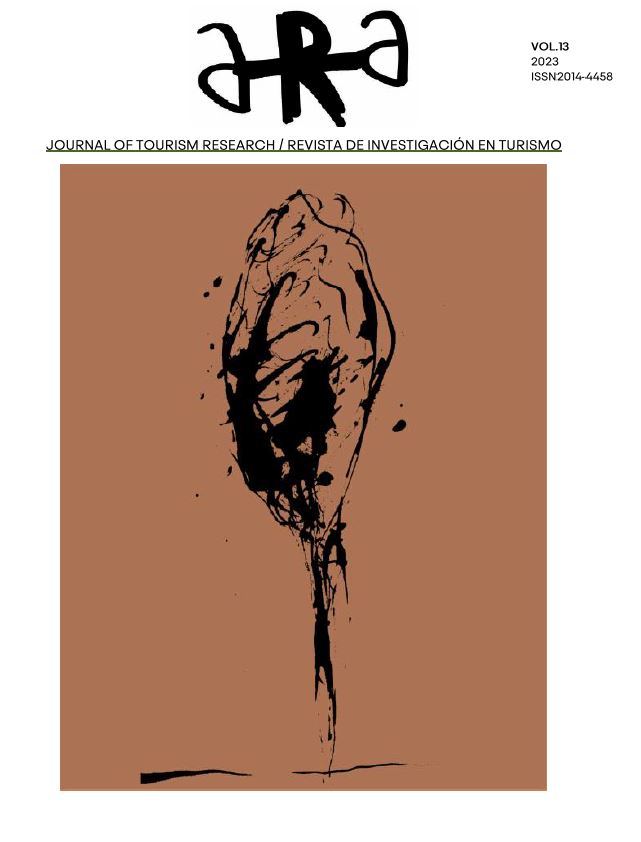Can cultural ecosystem services be the basis for a theoretical model of alternative tourism?
DOI:
https://doi.org/10.1344/ara.v13i1.42856Keywords:
general theory of systems, geography, research work, ecosystem servicesAbstract
This article proposes a theoretical model of alternative tourism based on cultural ecosystem services. It is based on the general theory of systems, physical and human geography and tourism models. The methodology used was the in-depth review of documents that have been developed in science on these concepts and models, the subsystems of the model were selected and classified and the relationship that is generated between them is explained. As a result, the model proposal is presented, since there are endless proposals; however, this is an innovative proposal since it is still necessary to explain the relationship that is generated between alternative tourism and cultural ecosystem services. Concluding with a model that can make significant contributions to geography and tourism, this opens up new lines of research.
References
Acerenza, M. (2016). “Conceptualización, origen y evolución del turismo”. Editorial Trillas. ISBN 968-24-7644-5. https://www.entornoturistico.com/wp-content/uploads/2017/11/Conceptualizaci%C3%B3n-origen-y-evoluci%C3%B3n-del-turismo-de-Miguel-Acerenza-PDF.pdf
Acevedo, J. A.; García, A.; Aragón, M. & Oliva, J. M. (2017). “Modelos científicos: significado y papel en la práctica científica”. Revista Científica, Universidad Distrital Francisco José de Caladas. Pág. 155-166. Doi: https://doi.org/10.14483/23448350.12288.
Autor. (2011). “Enfoques teóricos para aplicaciones concretas: complejidad y turismo”. Revista Gestión Turística. No. 15. https://www.redalyc.org/pdf/2233/223318904005.pdf
Autor. (2019). “Modelos turísticos desde la Teoría General de Sistemas”. SSRN. https://papers.ssrn.com/sol3/papers.cfm?abstract_id=3462803
Autor. (2020). “Sistemas complejos y turismo: aplicación del modelo de turismo armónico en dos localidades de países latinoamericanos”. Cuadernos de Geografía: Revista Colombiana de Geografía, 29(2), 354-372. https://doi.org/10.15446/rcdg.v29n2.79570
Bejarano, E. (S/F). “Una Geografía del Turismo para la comprensión de la territorialización turística”. Cooperación Universitaria UNITEC. http://observatoriogeograficoamericalatina.org.mx/egal12/Geografiasocioeconomica/Geografiaturistica/05.pdf
Bocco, G. (2003). “Carl Troll y la ecología del paisaje”. Gaceta Ecológica. No. 68. Julio-septiembre. https://www.redalyc.org/pdf/539/53906807.pdf
Bollo, M. (2017). “La Geografía del paisaje y la Geoecología: Teoría y enfoques. Paisaje: métodos de análisis y reflexiones”. Ed. Ediciones del Lirio - Editorial UAM. México.
Boullón, R. (2006). “Planificación del espacio turístico”. Editorial Trillas. Cuarta Edición. http://prepacihuatlan.sems.udg.mx/sites/default/files/planificaciondelespacioturisticorobertoc.boullon.pdf
Canchola, Y. (2017). “Propuesta metodológica para el análisis y valoración geológica del paisaje”. UAEM. http://ri.uaemex.mx/handle/20.500.11799/66175
Casas, I. (2004). “Percepciones del paisaje”. Revista de Arquitectura. No. 6. Pág. 8-12. https://www.redalyc.org/pdf/1251/125117709003.pdf
Cassini, A. (2016). “Modelos científicos”. Diccionario Interdisciplinar Austral. Editado por Claudia E. Vanney, Ignacio Silva y Juan F. Franck. http://dia.austral.edu.ar/Modelos_científicos
Cerón, H. (2020). “El turismo doméstico como base de la recuperación post Covid-19 de la actividad turística en México”. Revista Latinoamericana de Investigación Social. Vol. 3. No. 3. http://revistasinvestigacion.lasalle.mx/index.php/relais/article/view/2821
DATATUR. 2015. Glosario. Portal del Sistema Nacional de Información Estadística y Geográfica de Turismo (SNIEGT). https://www.datatur.sectur.gob.mx/SitePages/Glosario.aspx
Entremont, A. (1997). “Geografía Económica”. Edición Cátedra. https://dadun.unav.edu/handle/10171/47914
Gutiérrez, R. (2014). “Lo que los profesores de ciencia conocen y necesitan conocer acerca de lo modelos: Aproximaciones y alternativas”. Revista Bio-grafía. Escritos sobre la biología y su enseñanza. Vol. 17. No. 13. Julio-diciembre 2014. Pag. 37-66. https://revistas.pedagogica.edu.co/index.php/bio-grafia/article/view/2993/2680
Lynch, K. (1960). “La imagen de la ciudad”. https://www.academia.edu/7869348/Kevin_Lynch_La_Imagen_de_la_Ciudad
Medina, P. J. (2016). “Las teorías de la localización en el contexto de la Nueva Geografía Económica”. Grado de Economía. Facultad de Ciencias Económicas y Empresariales. Universidad de Almería. http://repositorio.ual.es/bitstream/handle/10835/6866/11984_Medina%20Al%C3%ADas%2C%20Pablo.pdf?sequence=1&isAllowed=y
Moragues, D. (2006). “Turismo, cultura y desarrollo”. (Fragmentos de la publicación del mismo título, en proceso de edición por AECI). Organización de Estados Iberoamericanos para la Educación, la Ciencia y la Cultura. http://www.cervantesvirtual.com/obra/turismo-cultura-y-desarrollo--0/
Navarro, D. (2015). “Recursos turísticos y atractivos turísticos: conceptualización, clasificación y valoración”. Cuadernos de turismo. No. 35. Pág. 335-357. https://www.redalyc.org/pdf/398/39838701014.pdf
Paredro. (2019). “Logo del día: Pueblos mágicos, un rehilete de colores”. https://www.paredro.com/el-logo-de-pueblos-magicos-es-un-rehilete-de-colores-con-un-significado/
Ruíz, R. (2007). “El método científico y sus etapas”. http://www.index-f.com/lascasas/documentos/lc0256.pdf
Sánchez, A. & Vargas, E. E. (2015). “Turismo sustentable. Un acercamiento a su oferta”. Revista Multiciencias. Vol. 15. No. 3. https://www.redalyc.org/pdf/904/90444727013.pdf
Santana, A. (2003). “Turismo cultural, culturas turísticas”. Revista Horizontes Antropológicos. Vol. 9. No. 20. http://www.scielo.br/scielo.php?script=sci_arttext&pid=S0104-71832003000200003
SECTUR. (2002). Turismo Alternativo. “Una nueva forma de hacer turismo”. Fascículo 1. Serie Turismo Alternativo. https://cedocvirtual.sectur.gob.mx/janium/Documentos/006145.pdf
SECTUR. (2018). “Resultados de la actividad turística enero 2018”. https://www.datatur.sectur.gob.mx/RAT/RAT-2018-01(ES).pdf
SECTUR. (2018). “Sexto Informe de Labores 2017-2018”. http://www.sectur.gob.mx/wp-content/uploads/2018/09/SEXTOinformeSECTUR_B.pdf
SEFA. (2018). “Realismo Científico”. http://www.sefaweb.es/realismo-cientifico/
Segundo, J. (2013). “Propuesta de creación de la Ruta Los Volcanes”. TTG Maestría. UAEM. http://hdl.handle.net/20.500.11799/14312
Serrano, R. (2008). “Hacia un modelo teórico-metodológico para el análisis del desarrollo, la sostenibilidad y el turismo”. Economía, Sociedad y Territorio. Vol. VIII. No. 26. Pág. 313-355. https://www.redalyc.org/articulo.oa?id=11182603
Somarribas, L. (2010). “Nuevo orden de la geografía de la población”. Revista Geográfica de América Central. Vol. 1. No. 44. Pág. 53-72. Universidad Nacional Heredia, Costa Rica. https://www.redalyc.org/pdf/4517/451744660004.pdf
Unikel, L. (1978). “El desarrollo urbano de México. Diagnóstico e implicaciones futuras”. Colegio de México. Segunda Edición. http://www.cervantesvirtual.com/obra/el-desarrollo-urbano-de-mexico-diagnostico-e-implicaciones-futuras-924525/
UNWTO. (2023). “El turismo va camino de recuperar los niveles prepandémicos en algunas regiones en 2023”. https://www.unwto.org/es/taxonomy/term/347#:~:text=A%20pesar%20de%20los%20crecientes,de%20d%C3%B3lares%20registrados%20en%202019.
Vara, J. L. (2008). “Cinco décadas de Geografía de la percepción”. Universidad Autónoma de Madrid. Dialnet-CincoDecadasDeGeografiaDeLaPercepcion-2927235.pdf
Downloads
Published
How to Cite
Issue
Section
License
Copyright (c) 2023 Luis Guadarrama García, Miguel Ángel Balderas Plata, Jesús Gastón Gutiérrez Cedillo, Bonifacio Pérez Alcántara, Yanelli Daniela Palmas Castrejón

This work is licensed under a Creative Commons Attribution-NonCommercial-NoDerivatives 4.0 International License.
The authors who publish in ARA agree to the following terms:
- Authors retain copyright and grant the journal the right of first publication.
- Texts will be published under a Creative Commons Attribution License that allows others to share the work, provided they include an acknowledgement of the work’s authorship, its initial publication in this journal and the terms of the license.
- This material may not be used for commercial purposes.
- You may not distribute the modified material.
Attribution-NonCommercial-NoDerivatives 4.0 International (CC BY-NC-ND 4.0)














